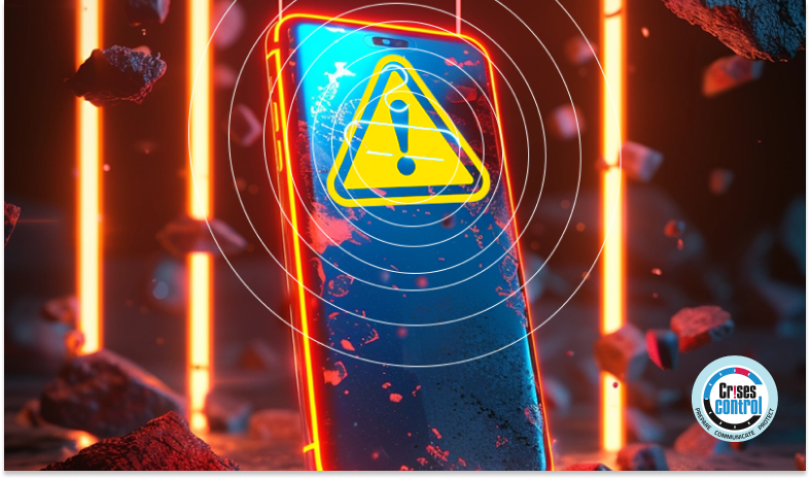In today’s fast-paced and interconnected world, businesses face a multitude of challenges that can disrupt operations and jeopardise the safety of their employees and stakeholders. From natural disasters to cyberattacks and everything in between, the ability to effectively communicate and respond to emergencies is paramount. This is where the emergence of emergency notification apps comes into play, revolutionising the way organisations manage crises and ensure the safety and well-being of their personnel.
In this blog, we explore the transformative power of these apps, highlighting their benefits, impact, and how they stand tall against conventional communication methods like WhatsApp. Join us as we unlock the potential of emergency notification apps and discover how they are revolutionising crisis management strategies worldwide.
Understanding Emergency Notification Apps
An emergency notification app is a powerful tool designed to rapidly disseminate critical information to designated individuals or groups during emergencies or crisis situations. It serves as a centralised platform where organisations can send real-time alerts, share updates, and coordinate response efforts seamlessly. Unlike traditional communication methods such as email or phone calls, which may be unreliable during emergencies, these apps offer instant and reliable communication channels, ensuring that vital information reaches the right people at the right time.
How Can It Help Businesses?
Emergency notification apps offer a wide range of benefits for businesses of all sizes and industries.
Firstly, they enable organisations to streamline their crisis communication processes, reducing response times and minimising the impact of emergencies. By providing a centralised platform for communication, these apps ensure that stakeholders receive timely and accurate information, allowing for swift decision-making and effective coordination of response efforts.
Moreover, emergency notification apps enhance employee safety and well-being by enabling organisations to quickly alert personnel about potential threats or hazards. Whether it’s a natural disaster, security breach, or health crisis, these apps empower employees to take proactive measures to protect themselves and others, ultimately saving lives and mitigating risks.
Safety and Ease of Use
One of the key advantages of emergency notification apps is their user-friendly interface and intuitive design. Unlike complex communication systems that require extensive training and technical expertise, these apps are designed to be simple and straightforward, allowing users to send alerts and updates with just a few clicks. With features such as predefined message templates, multi-channel delivery options, and real-time tracking capabilities, organisations can communicate effectively during emergencies without any unnecessary complexity or delays.
Furthermore, emergency notification apps prioritise security and data privacy, ensuring that sensitive information remains protected at all times. From encrypted messaging to secure authentication protocols, these apps employ robust security measures to safeguard communication channels and prevent unauthorised access.
Addressing Industry-Specific Needs
Different industries face unique challenges during crises. For example, healthcare facilities require immediate communication to mobilise medical teams during emergencies, while educational institutions need to alert students and staff during lockdown situations.
Emergency notification apps offer tailored solutions to address these diverse needs, enabling organisations to customise alerts, coordinate response efforts, and ensure timely dissemination of critical information across various sectors.
How It Stands Out from WhatsApp
While WhatsApp is a popular messaging platform used by millions of people worldwide, it is not specifically designed for emergency communication purposes. Unlike emergency notification apps, which offer dedicated features and functionalities tailored to crisis management, WhatsApp lacks the robust capabilities required to effectively address emergency situations.
For instance, WhatsApp does not provide the same level of customisation and control over communication channels, making it challenging for organisations to target specific groups or individuals during emergencies. Moreover, WhatsApp’s reliance on internet connectivity and mobile devices may pose limitations in areas with poor network coverage or during widespread emergencies.
In contrast, emergency notification apps offer offline capabilities, redundant communication channels, and integration with other critical systems, ensuring reliable communication in any scenario. Whether it’s sending mass notifications, conducting status checks, or monitoring response activities, these apps provide organisations with the tools they need to effectively manage crises and protect their assets.
How Crises Control Can Help
At Crises Control, we understand the importance of effective crisis communication and response. With our award-winning emergency notification software, organisations can enhance their preparedness, resilience, and response capabilities, empowering them to navigate even the most challenging situations with confidence.
Our platform offers a comprehensive suite of features designed to streamline crisis communication processes and ensure rapid response and recovery. From customisable alert templates and multi-channel delivery options to real-time reporting and analytics, Crises Control provides organisations with the tools they need to communicate effectively, mitigate risks, and safeguard their personnel and assets.
Conclusion: Take Control of Your Crisis Communication Strategy
In conclusion, emergency notification apps represent a paradigm shift in crisis communication, enabling organisations to respond swiftly and decisively to emergencies while prioritising the safety and well-being of their personnel. With their user-friendly interface, robust security features, and advanced capabilities, these apps offer a reliable and efficient solution for managing crises in today’s unpredictable world.
If you’re ready to take control of your crisis communication strategy and ensure the safety and resilience of your organisation, contact us today to schedule a free demo of Crises Control. Together, we can empower your organisation to effectively manage emergencies, protect your people, and safeguard your business operations. Don’t wait until it’s too late—take proactive steps to secure your future today.
FAQs
1. What is an emergency notification app, and how does it work?
An emergency notification app is a dynamic tool designed to rapidly disseminate critical information to designated individuals or groups during emergencies or crisis situations. It serves as a centralised hub where organisations can transmit real-time alerts, share updates, and coordinate response efforts seamlessly.
2. How can emergency notification apps benefit businesses?
Emergency notification apps streamline crisis communication processes, reducing response times and minimising the impact of emergencies. They provide a centralised platform for stakeholders to receive timely and accurate information, enabling swift decision-making and effective coordination of response efforts. Moreover, these apps enhance employee safety and well-being by promptly alerting personnel about potential threats or hazards.
3. What makes emergency notification apps stand out from other communication methods like WhatsApp?
Unlike WhatsApp, which lacks advanced crisis management features and relies on internet connectivity, emergency notification apps offer dedicated functionalities tailored to emergency communication needs. They provide offline capabilities, redundant communication channels, and seamless integration with critical systems, ensuring reliable communication in any scenario.
4. How do emergency notification apps address industry-specific needs?
Emergency notification apps offer tailored solutions to address the unique challenges faced by different industries during crises. For example, healthcare facilities require immediate communication to mobilise medical teams, while educational institutions need to alert students and staff during lockdown situations. These apps enable organisations to customise alerts, coordinate response efforts, and ensure timely dissemination of critical information across various sectors.








